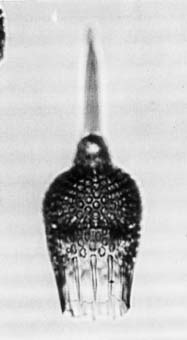 Calocycletta
(Calocycletta) virginis Haeckel
Calocycletta
(Calocycletta) virginis Haeckel[N1]
 Calocycletta
(Calocycletta) virginis Haeckel
Calocycletta
(Calocycletta) virginis HaeckelCalocyclas (Calocycletta) virginis Haeckel, 1887, p.1381, pl.74, fig.4; Riedel, 1959, p.295, pl.2, fig.8
Calocycletta virginis Haeckel, Riedel and Sanfilippo, 1970, p.535, pl.14, fig.10
Cephalis ovate, lobed, with usually sparse subcircular to circular pores, and bearing a stout apical horn that is usually conical but rarely weakly three-bladed. Thorax subspherical, with roughened surface. Thoracic pores circular, usually regularly hexagonally arranged, often with a tendency toward apparent longitudinal alignment, rarely with the longitudinal rows separated by long ridges. Usually no lumbar stricture externally. Abdomen subcylindrical or tapering distally, narrower than the widest part of the thorax. Abdominal pores subcircular or circular, usually smaller than those of the thorax, in most specimens longitudinally aligned. Terminal feet eleven to sixteen, lamellar, usually truncate, parallel, broader than the spaces between them, usually situated opposite alternate rows of abdominal pores (Riedel, 1959).
Length of apical horn 30-140 µm; of cephalis 35-40 µm; of thorax 65-130 µm; of abdomen 20-90 µm; of feet 10-45 µm. Breadth of cephalis 33-43 µm; of thorax 98-175 µm; of abdomen (distally) 78-100 µm (Riedel, 1959).
Thorax campanulate to hemispherical, without longitudinal ribs. Abdomen with a longer latticed part than C. costata and with numerous regular well developed lamellar feet originating at the same level (Riedel and Sanfilippo, 1978a).
This species differs from Calocycletta robusta Moore (1971, p.743, pl.10, figs.5-6) by the terminal structures being elongate, lamellar feet rather than triangular teeth. Thus the species can be unambiguously recognized only when assemblages are well preserved (Sanfilippo et al., 1985).
The stratigraphic range of this species spans most of the early Miocene. Early forms are transitional with C. robusta and have a heavy apical horn, hemispherical thorax and a strongly tapering abdomen. These early forms are distinguished from C. robusta by their regularly spaced terminal feet that generally begin at the same level on the abdomen and are of approximately equal width and length. Later forms may in some cases have a bladed apical horn, the thorax is less spherical and the abdomen has only a slight taper (Moore, 1972).
The cephalis is elongate-hemispherical, bearing a stout cylindro-conical horn, and the thorax is campanulate, inflated to a varying degree, with a slightly rough surface. The abdomen, with pores longitudinally aligned, is cylindrical or tapering distally, and from it depend 11-16 parallel, lamellar feet (Sanfilippo et al., 1985).
C. virginis is common in assemblages of late early Miocene to early middle Miocene age from low and middle latitudes in all oceans, including the Mediterranean region. Its morphotypic first appearance is approximately synchronous with the lower limit of the Cyrtocapsella tetrapera Zone and it becomes extinct within the Dorcadospyris alata Zone.
C. virginis apparently branched off from C. robusta, which persisted to evolve into C. caepa Moore (1972, p.150, pl.2, figs.4-7).
See Nigrini (1974, p.1096) for further taxonomic discussion.
Additional illustrations can be found in Moore, 1972, pl.1, fig.7; Goll, 1972, pl.14, figs.1-3.
For generic level phylogeny see Sanfilippo and Riedel, 1992, p.28.